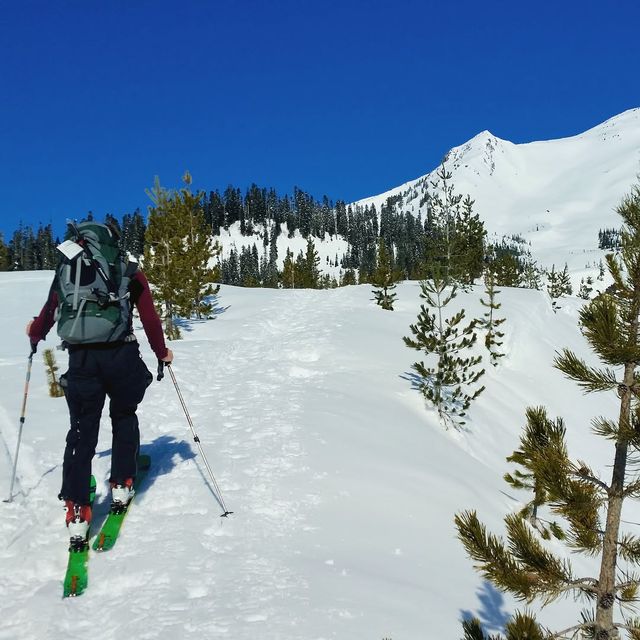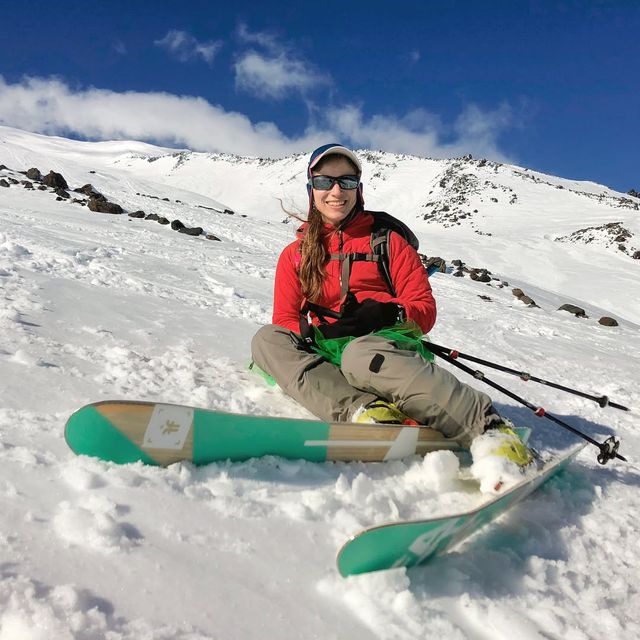I have many crafty friends. They can do everything from making their own clothes to building a pizza oven in their backyard. While I dabble in baking and have on occasion made my own Halloween costume, I would not consider myself endowed with an artistic or maker soul. And yet, I have spent most of my career architecting and building digital creations, so there does seem to be a hint of aptitude. It feels a bit wrong to have the capability to be a thing, be strongly interested in becoming that thing, and never striving to become it.
Given my proclivity towards outdoor pursuits and the need to modify or maintain gear, it seemed about time for me to stop being lazy and force myself to start developing the necessary skills and experience to do it myself instead of spending money to let someone else perform the work. One thing that grabbed my interest recently was waxing my own skies. We do enough backcountry and resort skiing around here that multiple waxes a season are called for to keep us gliding nicely down the slopes. Further, an older pair of climbing skins had recently left sticky bits of glue on the bottom of my backcountry skis and another trip was rapidly approaching, so last week I decided to clean my skis and give them a good waxing all by myself.
I started by cleaning the bottom of my skis with Goo Gone. The citric acid based cleaner I had was ineffective against the glue residue so something with a bit more oomph was required. The Goo Gone effectively removed the glue but it also took most of my existing base of wax with it. I rinsed them heavily in the shower and let them dry for an hour.
Now for the waxing. Tina had a friend who moved away and left her a ziplock bag containing a sanding block and two tubes of wax. Now, when I first saw these a couple months ago, Tina recalls me mentioning that they were cross country ski waxes. Oh, if only I had been so astute last week as I was two months ago.
I hunted around for that ziplock bag and plucked it out of one of our gear containers. Looking at the tubes of wax, I chose the one that seemed to have the correct temperature rating for our current mountain conditions. Amazon has a nice image of the SWIX Blue Wax I decided upon. If you're an older school cross country skier, you may already know where this is going. In a haze of Goo Gone fumes, it did not even enter my mind that it may be the wrong kind of wax for downhill skiing.
After covering my desk with paper to protect it from dripping wax, I flipped my skis over and braced them on top. I took a recently purchased cheap iron and turned it on to warm up. Even before I started melting, a niggling thought had entered my mind: "That's not very much wax for two skis." I knew it was supposed to be a thin layer of wax, so I told myself I was meant to be efficient and pushed the thought away. The wax was also quite sticky at room temperature. But, it was obviously meant for winter temperatures and not a 65 degree living room. Another thought pushed away.
I slowly pressed the wax against the iron and it melted down onto the ski. It was an exciting new experience dribbling little droplets of wax back and forth between the edges of my ski. After a foot though, I needed to pause and pull down the edge of metal that was wrapped around the tube of wax. It was a royal pain to do and I actually had to get a pair of tweezer to help pull it away. Another odd thing as it did not seem quite right that one would have to continually pull away a metal wrapper while waxing one's skis. Still, I reckoned this was yet another case of me being inexperienced. Obviously I should have pulled off the entire metal wrapper before starting.
Once I had droplets up and down the entire ski, I moved the iron back and forth to slowly remelt the drops and create a thin layer of wax across the ski’s entire surface. That part went smoothly. There was a small amount of overflow that spilled over my edges, but I knew I would simply be scraping that away after the wax cooled.
The first ski took me about 25 minutes to completely wax because of the metal peeling but the second one took less than 10 minutes since I had learned how quickly I could melt and spread the wax. Upon finishing, I put the skis in the bathroom to cool for an hour. While they cooled, I biked over to a nearby outdoor store and purchased both a scraper and nylon brush. Neither was in the bag Tina’s friend had given her, which seemed odd, but maybe her friend wanted to keep those items for himself.
At this point I would like to point out the number of times I thought something was wrong but simply pushed the thought away and blamed it on my complete inexperience with waxing skis. Hm. Hmmmmmm.
I came back from the store and took the first ski out of the bathroom. What struck me first was that the wax was definitely still pretty tacky. Maybe it was not cool enough? Put it on the balcony for another 20 minutes. Made a cup of tea and read an article online about how to scrape and brush your skis after waxing.
Brought the ski in from outside, braced it, and tried to scrape the wax away. Huh. The wax was not really coming off the ski so much as becoming a tough, sticky residue against the scraper. I paused and looked at the wax on the bottom of my ski. Something was wrong. I tried again. The wax was solidly sticking to the ski and the scraper, not coming off at all. Something was definitely not right here.
I headed to the internet and did a few searches. What causes gooey, non-scrapeable ski wax? Was it my usage of Goo Off? Temperature? Does wax go bad? I am embarrassed to say, it took me a solid 15 minutes before I thought to look up the wax on the SWIX website. The tube I was using was not under Alpine or Alpine Touring. And then I found it. Kick wax. Holy hell.
If you do not know, Kick Wax is also know as Grip Wax and is used with waxable Cross Country Skis. It is put on the middle part of your ski underneath the binding and is there to give you the grip you need to push off and move when you push down. It is most definitely not meant for alpine skis and is the exact opposite of glide wax.
The last time I had done anything with Kick Wax was way back at Reed some 20 years ago. It is somewhat uncommon now thanks to waxless cross country skis. Nowhere on the wax tube did it indicate it was Kick Wax but I obviously had realized what it was two months ago. In my haste to try something new and get my skis waxed for a trip the next day, I never paused to consider if I was using the wrong wax. Oops.
By the way. Kick Wax is also a royal pain to remove. Exhausted by the hours of now completely useless work, I put the skis away and moped the rest of the evening away.
–––
I ended up snowshoeing for my trip the next day, which was a really good call as we were pulling a friend’s 11 month old in a sled with fresh snow and having that maneuverability came in extremely handy. A few days later with another ski trip planned, I stopped by the outdoor shop, purchased Glide Wax, and decided to give waxing another shot.
First, I used the iron on a low temperature to slowly heat up the Kick Wax and then wiped as much of it away as possible. I then used Goo Gone multiple times in the shower to remove the remainder. Took about an hour. Not a very fun hour either.
I set up my table with protection again and braced my skis. The Glide Wax melted thin and quickly. I had the bottom of both skis coated in a nice thin layer of wax in under 15 minutes. It was night and day compared to the first time. Given their harsh cleaning, I let the wax sit on them for the rest of the afternoon while I went out for a few hours.
That night I used my scraper and scraped off the wax. It came off in delightfully light, creamy shavings. Ahhhh, this was how it was supposed to go! You cannot scrape off too much apparently, so I gave it a number of goes. Next, I used my nylon brush and cleaned off more wax before polishing it with some felt. By the end the bottom of my skis had a clean, polished look that felt right. The truth would come the next day.
Downhill skiing on Saturday at Mt. Hood Meadows was epic as they were in the midst of a storm that would bring in more than two feet of fresh powder. And the skis worked great. I could tell they were just a bit cleaner and slippier than before.
So, yeah, lessons learned, experience accumulated, merit badge unlocked. It was a bit exhausting to fail so completely and then have to fix my mistake and start over, but it got done and I am richer for the experience. Still feel a boneheaded, but therein lies the truth of learning: you’re usually slightly foolish at the start.

